How Can I Make My Tyres Last Longer?
Tyres are your first line of defence when it comes to driving safely, so investing a little time and care in looking after them pays big dividends. Simple, regular checks are easy for anyone to carry out, so here are our tips for keeping your tyres in perfect condition and making them last longer.

Be prepared
There’s not a lot of point checking your car’s tyres if you don’t know what you’re looking at other they’re round and made of rubber. So, arm yourself with the owner’s manual so you know what pressure the tyres should be.
It also saves a lot of hassle if you have a tyre pump at home. You can buy foot-operated pumps or, better still, electric ones that plug into the car’s own power socket. So, you can check the tyres anytime, anywhere. And when you buy a pump, add in a can of tyre sealant as a get-you-home measure in case of a puncture.

Check them all round
Before unscrewing the valve cap on a tyre, take the time to have a good look all around the side wall and across the tread. You can also inspect the inner edge of the front tyres by turning the steering fully from one direction to the other.
Make this part of a weekly routine when you fill up with fuel or wash the car.
What you’re looking for is anything unusual, such as bulges, splits, cracks or nails that might have become embedded in the tyre. Even the smallest tear can have serious consequences at 70mph. If you’re in any doubt about the tyre’s condition, have it checked by a garage or tyre fitter.
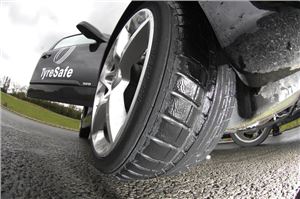
Tread carefully
In the UK, the law states the minimum tyre tread depth is 1.6mm across three quarters of the width of the tyre. However, this is the absolute minimum before you risk a fine and penalty points for a defective tyre. Depth gauges can be bought at most car parts shops.
A much better idea is to change a tyre when it reaches a tread depth of 3mm, which is about the thickness of a one pound coin. That might sound like you’re throwing away good rubber, but the difference is a tyre with only 1.6mm tread needs an extra three bus lengths to stop in wet weather compared to one with 3mm tread.
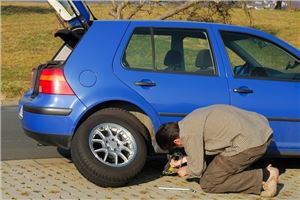
Spare some thought
Cars have four tyres, right? Yes, but many have an extra one hidden in the boot as a spare. When you check the rubber on the road wheels, don’t forget to do the same for the spare as you will regret neglecting it if you suffer a puncture.
It’s also worth checking the age and condition of a spare tyre when buying a second-hand car as it may well be past its use-by date, which you can find on the sidewall. A can of tyre sealant is a handy get-you-home fix to keep tucked in the boot, too.
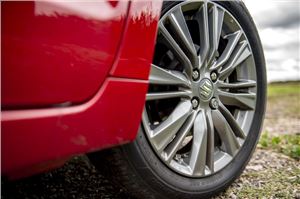
Go nuts
You can have the best cared for tyres in the world, but that means nothing if they don’t stay attached to the car. Alongside the tyre pressure figures in the owner’s manual should be the correct torque setting for the wheel nuts, which tells you how tightly they should be tightened.
If you don’t own a torque wrench, a tyre fitter can check every wheel nut on the car in one minute. Just make sure you have the security bolt most cars now use to prevent wheel theft so the mechanic can also tighten these nuts. You’ll also need this unique nut to get the wheel off to change the tyres.

Feel the pressure
You’ll find the correct pressures for your car’s tyres in the owner’s manual or often inside the fuel filler flap. They will be stated in ‘Bar’ or ‘PSI’, so make sure you use the same figures for every tyre and when adjusting their pressures. Always try to use the same pressure gauge so you know the readings are consistent across all four corners when you check them once a week.
Using a pump or compressor, you can add air to any tyre that is under-inflated. Add a little at a time and check with the gauge until the tyre is at the right level. Avoid over-inflating and then letting air out through the valve as this puts unnecessary strain on the tyre. Over-inflated tyres wear more quickly, while tyres under-inflated by 10PSI can cause a 6 percent reduction in fuel economy.
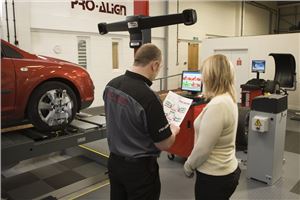
Straighten up
Driving your car wears out the tyres, but misalignment can cause premature wear that reduces tyre life by 25 percent and even creates dangerous bald patches. If you feel any shimmy through the steering or notice the car doesn’t drive in a perfectly straight line when your hands are just resting on the wheel, get the car’s alignment checked.
Most garages can check the geometry and tracking of any car and reset it so the car drives arrow straight. Not only does this lessen tyre wear, it also puts less strain on the steering and suspension components to save you money on future garage bills.

Drive with care
Tyres are the only contact between your car and the road, so the more you care for them the better they will protect you. As well as inspecting them for damage and correct pressures, your driving has a big bearing on how long they will last.
Try to avoid heavy acceleration, especially at low speeds, and harsh braking as these manoeuvres put a lot of strain on the rubber. The more smoothly you drive, the easier it is for the tyres to grip and do their job properly without excess wear.

Kerb appeal
Many drivers worry about the alloy wheels on their car being damaged against kerbs, but you should be more concerned about the tyres being scuffed or mutilated. Sharp edges can puncture a tyre or, more worryingly, leave damage that leads to a blow-out.
Try to park close to the kerb by not rubbing up to it. When parking, don’t bump the tyres over the kerb to get into a space.
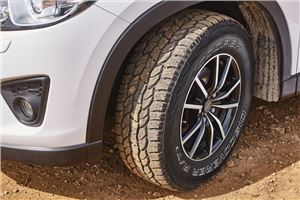
Monitoring systems
Many newer cars have a TPMS (tyre pressure monitoring system) fitted that checks the pressures in each of the four tyres. If a tyre is under-inflated, it flashes a warning on the dash, which can be an MoT failure if left unattended.
While the TPMS is a handy gadget to have on your car, it’s no substitute for regular checks of the tyres’ condition, tread and pressure by you. When the tyres are the only thing keeping your car on the road, it’s worth spending a couple of mi


![2016 BMW 4 Series Gran Coupe 420d [190] M Sport 5dr Auto [Professional Media]](http://images.honestjohn.co.uk/imagecache/url/crop/90x60/https/assets.heycar.co.uk/t_default-export/f_auto/application_assets/vehicles/pictures/97aed0208c144a3ae2718ddc7f04dc7c/36216b8d320d7b916162624512ae5470.jpg)

![2020 Fiat Panda 4x4 0.9 TwinAir [85] 4x4 5dr](http://images.honestjohn.co.uk/imagecache/url/crop/90x60/https/assets.heycar.co.uk/t_default-export/f_auto/application_assets/images/holding.jpg)

.jpg)





